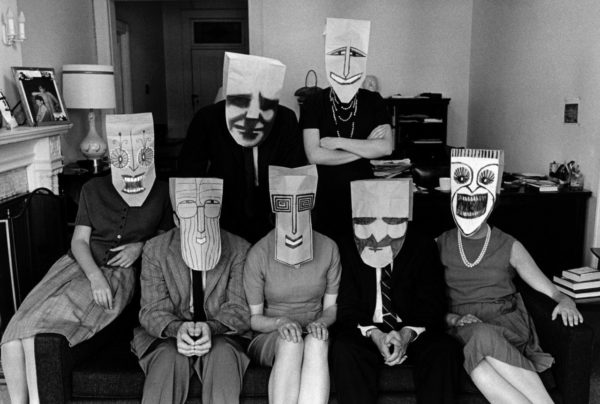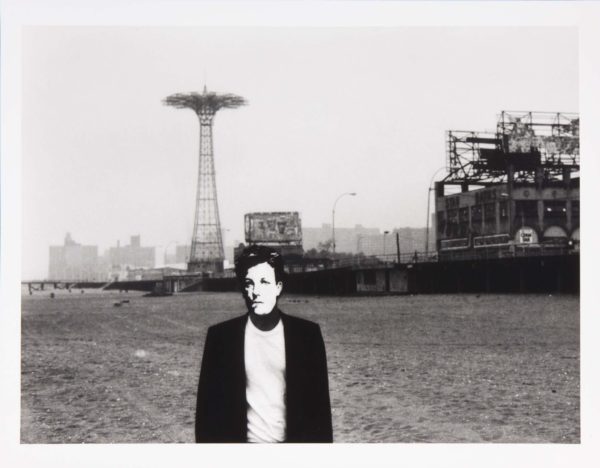
“Man is least himself when he talks in his own person. Give him a mask, and he will tell you the truth.”
—Oscar Wilde“It’s Halloween… I’ve got my Bob Dylan mask on.”
—Bob Dylan, 10/31/1964
Our second pandemic Halloween is coming up, so I’m thinking about masks. Specifically, how much I love photo projects that involve people wearing masks.

I’ve recently become interested in the photographs of Ralph Eugene Meatyard. In the late 50s in Kentucky, Meatyard, an optician who called himself a “dedicated amateur,” found a bunch of masks in a Woolworths and “over the next 13 years, Meatyard persuaded a procession of family and friends to don one of the Woolworths masks and pose in front of his camera.”
[Photographer Emett] Gowin, who posed for a Meatyard portrait, recalls thinking that wearing a mask would surely erase all sense of personhood. “But when I saw the pictures,” he says, “I realized that even though you have the mask, your body language completely gives you away. It’s as if you’re completely naked, completely revealed.”
Meatyard, btw, wasn’t some lone outsider — he was a part of Lexington’s artistic and literary scene. (Here’s a nice essay that points out the connection between Meatyard’s work and Ambrose Bierce’s The Devil’s Dictionary.)

One of my favorite little art books is photographer Inge Morath’s Saul Steinberg Masquerade, a collection of portraits from the turn of the 50s/60s of people wearing Steinberg’s paper-bag masks.
These pictures remind me of something Vlad Nabokov wrote in Strong Opinions:
I don’t think that an artist should bother about his audience. His best audience is the person he sees in his shaving mirror every morning. I think that the audience an artist imagines, when he imagines that kind of a thing, is a room filled with people wearing his own mask.
More from Morath’s book here.

Another series worth mentioning is David Wojnarowicz’s Arthur Rimbaud in New York, photographs he shot in the late seventies of people standing in various NYC places wearing a mask of the poet Arthur Rimbaud.
“What is it about masks and loneliness?” Olivia Laing asks in the Wojnarowicz section of The Lonely City.
The Rimbaud images are often mistaken for self-portraits, but in fact Wojnarowicz stayed behind the camera, using multiple friends and lovers to play the part of the mask-wearer. Nonetheless, the work is deeply personal, albeit in a complicated way. The figure of Rimbaud served as a kind of stand-in or proxy for the artist, inserted into places that mattered to David, places where he’d been or which still exerted a power over him.
If you include the fact that Steinberg called himself a “writer who draws,” all these mask photos have literary links.
And there’s one more link I can think of: the word “hypocrite.”
The word hypocrite ultimately came into English from the Greek word hypokrites, which means “an actor” or “a stage player.” The Greek word itself is a compound noun: it’s made up of two Greek words that literally translate as “an interpreter from underneath.” That bizarre compound makes more sense when you know that the actors in ancient Greek theater wore large masks to mark which character they were playing, and so they interpreted the story from underneath their masks.
Only later did the word come to mean “any person who was wearing a figurative mask and pretending to be someone or something they were not.”
(Another word to look up: Maskenfreiheit.)
The mouth holes of these Ancient Greek masks were engineered to help the audience hear the actors’ voices. (The mask helped amplify and project what was underneath.) But interestingly, some people like classicist Peter Meineck think it was the ambiguous emotional nature of these masks that made them so effective for drama:
The magic of the mask lies in how it transmutes depending on the angle and context in which we see it. Tilting a mask up and down can change its expression from enraged to content, while a human face is far more consistent from all angles. Because there is no face to tell you explicitly the emotion the character is feeling, your brain takes cues from movement and assigns the face an expression that makes sense. “Your cognitive system is seeing and suggesting the mask moving,” Meineck says.
The mask is a hypnotic call to theatre precisely because each audience member helps to create the emotional drama unfolding on stage. “I believe the mask is far more expressive than the human face,” Meineck says. Rather than being told what to see by an actor’s face, the audience plays a role in creating the emotion, projecting onto the mask what should be there rather than what is explicitly present, similar to the way the brain works to find meaning in abstract art.
(See: “The Neuroscience of the Tragic Mask”)
— Austin Kleon (@austinkleon) October 26, 2021
If you have other mask photography series you think I should see, reply to this thread!
